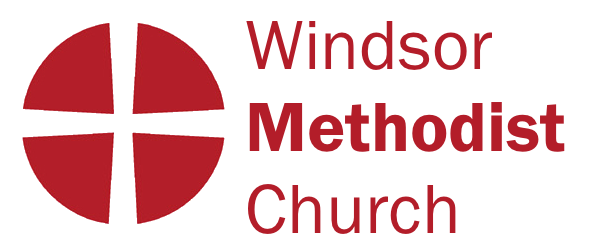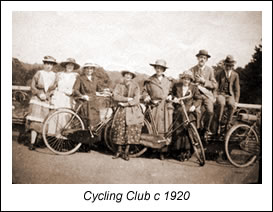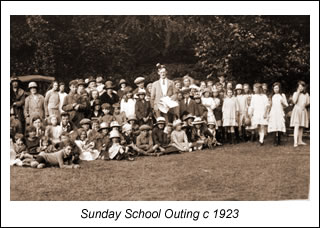History of the Windsor Methodist Church
Adapted and updated from John Preston's 2003 summary and update to Jean Kirkwood's book, The Methodist Church Windsor. The Centenary Story (1977)
Windsor Wesleyan Methodist Church, pre-Alma Road
The roots of Methodism in Windsor are very nearly as old as Methodism itself. It was only four months after John Wesley had felt his “heart strangely warmed”, during the famous events of 24th May 1738, that he first preached in Windsor. His Journal records quite simply for Tuesday, 26th September 1738, “I declared the Gospel of peace to a small company in Windsor.”. That was the first of 14 visits in as many years.
By 1748 John Wesley makes reference to “members of the society” in Windsor, but sadly there are no records tracing further developments until 1800, when a Mr John Ould attended a prayer meeting in Windsor. He became the mainstay of Methodism in Windsor, and it appears that his house was the society's meeting place. By 1815 membership had reached 26, and in the following year a body of Trustees was formed to arrange for the erection of a Chapel, with Rev Thomas Robinson appointed to be the Minister. A small Chapel was duly built in Bier Lane (now River Street) which was a heavily populated area in those days. It soon became too small, and a gallery was added, re-opening in July 1825. The minister, Rev Alexander Strachan, stated:
In no Circuit in which I have travelled these ten years past have I discovered a greater depth of piety or more ardent spirit of prayer of brotherly kindness and charity than exists in the Methodist Society in Windsor.
It was in the Bier Lane Chapel that John Higgs, a native of Maidenhead, was converted in 1829 and he set to work to take Methodism to Maidenhead.
The membership clearly grew well in the early 19th Century and a gallery had to be added to the Chapel. Even so, Bier Lane was bursting at the seams. In 1837, larger new premises were opened just off Peascod Street (now part of King Edward Court). Records do not show why the Peascod Street Chapel lasted only 40 years. There were certainly concerns that it was tucked away down a passage off the street, and presumably a more prominent edifice was considered desirable! And so, in 1874, the Quarterly Meeting gave permission for the erection of a new Chapel at a cost of £6,000. How many millions is that at today's prices? But the worshippers raised the money.
(The Peascod Street Chapel was sold in 1886 and was eventually acquired by the Windsor Steam Laundry Company who used it for 90 years before it was demolished as part of the redevelopment of the area into the King Edward Court shopping complex, opened by Her Majesty the Queen on 8th April 1980.)
Windsor Primitive Methodist Church, Denmark Street
In the Spring of 1838, Rev John Ride and Rev Aaron Bell from the Reading (Primitive) Circuit, visited Windsor. The Windsor Mission of the Reading Circuit was established on 5th May 1839. It soon became the Windsor Branch of the Reading Circuit, but was renamed the Maidenhead Branch in 1845, becoming shortly afterwards the Maidenhead Circuit in its own right.
A Chapel was built in Denmark Street, Windsor and the first services were held on 29th May 1853. The Circuit plan for 1858 gives Windsor as holding services at 11 am, 3 pm and 6 pm on Sundays, and 7 pm on Thursdays.
In 1882 the Maidenhead Circuit split, and Windsor became the centre of the new Windsor Circuit.
The society did not prosper, World War 1 took its toll and membership dropped. Shortly after the war, the Society decided they could no longer sustain themselves. The Chapel was closed, and sold to the Church of England to replace the Mission Church in River Street, which had become a clearance area. This continued until the 1960s when the area was rebuilt as the Ward Royal housing complex (opened by the Queen on 29th June 1969).
Alma Road Methodist Church
As can be seen in the Alma Road Chapel, the foundation stone of the present Church was laid on 8th May 1876 and the new building opened on 21st February 1877. The members were justly proud of their marvellous new Church. It was heated by Grundy's Hot Air Apparatus, with fresh air drawn in at vents on the windowsills. In good Methodist tradition the pulpit was placed centrally, against the south wall, and the organ (installed in 1879) shared the north gallery with the choir for many years.
The Church members were very active. A Band of Hope was formed in 1862 and a “Juvenile Missionary Society” in 1869.
There was a flourishing Sunday School. A summer treat became an annual event, including an enterprising but highly successful outing to Hampton Court in 1872. The following year they went to Burnham Beeches, a venue to which they returned again and again. The teachers used to get to the Church around 6.30 am on the day of the outing to prepare the food. Trestles, forms and everything necessary for the occasion were taken with them in coal carts which were borrowed for the occasion!
Over the years collections for the National Children's Home and Orphanage were often taken at special services. In 1907 a house-to-house collection was made on their behalf – an early instance of this fund-raising activity. Members placed great emphasis on helping those less fortunate than themselves. They gave gifts of coal and money to members who had fallen on hard times. In 1877 they subscribed to the Indian Famine Relief Fund, to the New Brunswick Fire Fund, and to the Fund for “Worn Out Preachers”!
The Church was alert to the opportunities for evangelism, and worked amongst the soldiers garrisoned at Windsor Barracks. Mr Brocklehurst founded the Windsor Wesleyan Christian Workers' Association for young people, its main object being evangelism in the neighbourhood, including open air meetings. They also took it upon themselves to keep the boys in the Gallery more orderly! In 1891 they were ordered to move on when conducting an open air service. They decided to send a deputation to the Watch Committee, and meanwhile to take no notice “of the order to move on”.
The Wesley Guild was inaugurated in 1895, and Windsor's Guild, started in 1897, met on Wednesdays as it does still.
In 1906 the Church and Schoolroom were renovated, a more efficient system for heating the Church was installed, and the organ was moved from the choir gallery to behind the pulpit. The Mayor granted the use of Windsor Guildhall for services for three weeks while the Church was closed. At the re-opening, the ladies wore elaborate hats and some of the men had top hats. An idea of the occasion might be gleaned from this Church members' river trip in 1909.
Throughout the twentieth century, although some organisations had their ups and downs, many activities continued to flourish. There was a great sense of community. Scouting was introduced to the Church by Mr Frank Soons in 1915. This was followed by a Cub Pack and then Rovers. Guides started in 1926. Although first and foremost a meeting with a devotional character, the Women's Own took time out for outings, such as the one shown here leaving the Church in 1925. The Sunday School summer outings continued, mainly to Burnham Beeches, but in 1930 a daring innovation was a trip to Bognor.
Windsor Methodist Church
With the Act of Union in 1932, Alma Road Methodist Church became Windsor Methodist Church.
During 1932, James Sankey came to teach in Windsor and became a member. He went to the Gold Coast in 1936 as a member of the Methodist Missionary Society. When he returned to England he trained to become a minister, was ordained, went to India and became a Minister of the Church of South India at its inception.
In 1952 the Young Wives' Club was started for mothers with young children. Shortly afterwards the Ladies' Club was started – an evening meeting open to all women. Also in the 1950s there was a Men's Meeting, and the drama group Windsor Methodist Players started.
By 1960, the Church premises were showing signs of age, and in 1961 a major renovation scheme was launched linked with the call to Revival. Thanks chiefly to the many regular weekly donations over several years, more than £10,000 was raised, making possible the extensive renovation and re-decoration needed to see the building through the next 30 years.
In the late 1980s there was growing concern about the inadequacy of the Church building, particularly the two-storey Schoolroom section at the rear. After much prayerful study, a large scale Re-Development Scheme was agreed at the daunting cost of £800,000! Under the title Forward in Faith the venture was launched on 3rd June 1990 at a Grand Rally addressed by Viscount Tonypandy. Thanks to the enthusiasm and bright ideas of the Fund-raising Committee, and the dedication, generosity and hard work of very many people, the fund grew and the work began. We were helped very considerably at this time by the kindness of St Edward's Church, who gave us free use of their Schoolroom suite throughout the building phase. And finally, with great rejoicing, the re-developed Church was officially opened by Her Majesty the Queen (accompanied by the Duke of Edinburgh) on 6th April 1993. It was not actually the final step, because fund-raising had to continue for a further 3 years! But on 2nd June 1996, a joyful Thanksgiving Service completed the mammoth task.
In 2007 the Church received a very generous donation covering the cost of upgrading the previous audio system to include projection facilities both in the Church and in the hall downstairs. For major events the system is capable of projecting any activity in the Church, in the hall downstairs, or vice versa.
In the current decade, Windsor Church continues to be highly active. Many of the activities described above continue, and are detailed here. The Church seeks to provide a family friendly environment in which all are enabled to worship God. As well as services in the sanctuary, there is a crèche room connected to the worship area, so parents looking after young children can still share in worship. The recently renovated Cornerstone Chapel at the corner of the Church building is open every day for anyone who wishes to come in and pray or leave a prayer request or simply sit quietly for a while.
The Church's Outreach Committee organises special events and continues to raise money for various causes including the Whitechapel Mission. The young members of Windsor's Junior Missionary Association (JMA) raised nearly £1,000 last year for its missionary work.










